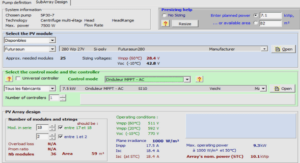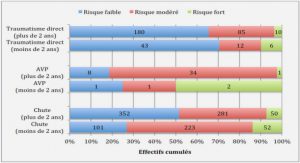Télécharger le fichier pdf d’un mémoire de fin d’études
Biofuels as a promising renewable energy resource
Biofuels have a tremendous potential in replacing fossil fuels. They can be described as a gas, a solid or a liquid that are produced from living organisms that contain energy from geologically recent carbon fixation. Biofuels can be created from biodegradable and renewable materials such as algal wastes, vegetable oils, animal fat or recycled cooking greases. Palm oil, rapeseed oil and soybean are the main sources of biofuel; palm oil is the most produced vegetable oil in the world and is largely promoted to produce biofuel.
Figure 5: Production (million metric tons) of major vegetable oils worldwide from 2012/2013 to 2017/2018 (figure from Statista).
The feedstock used for its production defines the category in which the biofuel belongs to.
Biofuels are categorized into four different generation biofuels (Figure 6).
The first generation of biofuels, also known as “conventional biofuels” are produced from sugars and vegetable oils that are found in crops.
Several limitations were observed, generating new challenges such as: competition with food crops which led to an increase in food prices, inability to meet all promising environmental benefits, acceleration of deforestation and competition with water resources in some regions where water is highly limited.
The second generation of biofuels, also known as “advanced biofuels” differ from the first generation by the fact that they don’t include food crops, unless the food crops have already been used as food and are no longer fit for human consumption. They refer to agricultural lignocellulosic waste therefore non-edible plant parts. They were therefore seen as a solution to the problems associated with 1st-generation biofuels since they are produced from waste products that are generated from other processes.
However, in the case of 1st and 2nd-generation biofuels, challenges such as land occupation leading to a clear competition between food and fuel remain. This is a major drawback in a context where the population grows along with the need for food, especially in developing nations.
Third generation biofuels refer to microalgae production. Indeed, microalgae are believed to be a promising resource for 3rd-generation biofuel as it offers tremendous advantages such as: a rapid growth rate and a high production capacity of lipids which are easily converted into biodiesel through thermochemical and metabolic processes.
As per estimates 50 000-140 000 liters of algae oil can be produced per hectare which is 10-30 times higher than oil crops such as palm oil.
Table 1: Oil content, biodiesel productivity of microalgae and second-generation feedstock (Medipally et al., 2014).
Algae are also far from the competition between food and fuel since they can grow using land and water that are unsuitable for food production (i.e. non-arable land or saline water) which also helps with the issue of depleting water from sensitive regions. Furthermore, microalgal biomass can be converted into different kind of fuels such as diesel, petrol and jet fuel.
The fourth generation of biofuels includes the use of methods such as genetical modifications or metabolic engineering on living organisms, mainly microalgae, with the aim of creating a sustainable energy through an optimization of the photosynthetic ability of the algal cell as well as capturing and storing CO2. In this strategy, CO2 is captured, compressed then transported to a specific storage location where it will be injected beneath the earth’s surface in for example deep aquifers or depleted oil and gas fields. This way, the carbon dioxide is isolated from the atmosphere for a long time. By capturing more carbon than it produces, this 4th generation of biofuels production has the potential of being carbon negative instead of carbon neutral (Mansor et al., 2015).
Industrial and biotechnological applications of microalgae
Biochemical composition: useful substances present in algae and their applications Besides biofuels, microalgae (and cyanobacteria) are considered as a promising sustainable source of various products for a broad range of industrial applications including food and non-food applications. These microorganisms, under specific conditions, can produce a large variety of compounds of interest such as lipids (up to 70 % of their dry cell (Chisti, 2007; Hu et al., 2008; Zhu, Li and Hiltunen, 2016)), proteins (up to 60 % DCW (Becker, 2007)), pigments (for example astaxanthin, up to 7 % from H. pluvialis; β-carotene, up to 12 % from D. salina; phycocyanin, up to 17.5 % from Arthrospira platensis (Spirulina) (Kang et al., 2005; Patel et al., 2005; Del Campo, García-González and Guerrero, 2007)), carbohydrates (up to 60 % DCW (Choi, Nguyen and Sim, 2010; Pruvost et al., 2011; Bondioli et al., 2012; Chen et al., 2013), and other high-value products such as EPA (around 39% of total fatty acids from Phaeodactylum tricornutum) and DHA (around 45 % from Crypthecodinium cohnii), both high value polyunsaturated fatty acids (PUFAs) (Cohen et al., 1993; Benedetti et al., 2004).
Major microalgal pigments
Algal pigments draw increasing attention for their high market values and are even perceived as the most promising products from algae that have the highest potential for commercial success (Koller, Muhr and Braunegg, 2014; Eriksen, 2016). The major part of algal pigments is associated with light occurrence, they are responsible for light harvesting (used for photosynthesis) and they protect the cells from the damage that could be caused by excessive illumination. They are also responsible for the macroscopic coloration of the algae culture. The major pigments found in microalgae are the following: chlorophylls (primary photosynthetic compound, responsible for green coloration), carotenoids (including carotenes, responsible for orange coloration, and xantophylls, yellowish coloration), and phycobilins (red or blue coloration).
Chlorophylls are one of the most important pigments found in nature. They selectively absorb light in the blue and red regions, which gives the green coloration and they are the most predominant algal pigments; chlorophyll a, one of the main types of chlorophyll with chlorophyll b, is an omnipresent pigment in all microalgae.
Chlorophylls have a potential in various applications. They are generally employed as food additive for coloration responding to the market demands of using natural coloring agents in food products. They are also, with their derivatives, used in other applications such as therapeutic and pharmaceutical applications due to their anti-cancer activity (Díaz, Li and Dashwood, 2003) and their ability to stimulate tissue growth which makes them attractive for the treatment of ulcers, oral sepsis or in proctology in the context of rectal surgery (Halim et al., 2010). They help increase the rate of tissue healing. Finally, they are also associated to an antibacterial property and a high deodorant capacity; they are therefore used to remove odors from the wound and as ingredients in personal hygiene products (deodorants…).
Carotenoids (carotenes and xantophylls), known as secondary light harvesting pigments, also have a major potential for various applications in market: as colorant in food (Shahidi and Brown, 1998; Eriksen, 2016) and cosmetics (Igielska-Kalwat, Wawrzyńczak and Nowak, 2012), for functional food products and cancer prevention due to their anti-oxidant activity (which also enables them to protect cells from the negative effects of excessive solar radiation). These pigments absorb light energy at wave lengths ranging from 400 nm to 500 nm (spectral ranges where chlorophylls can’t absorb energy).
β-carotene, also named vitamin A, is employed for nutritional purposes (vitamin supplement) but also human health for its major role in human metabolism to prevent negatives effects caused by free radicals. This pigment is often associated to the microalga Dunaliella salina; this microalga is mainly cultivated in Israel and Australia and can produce up to 14 % of its DCW (Paniagua-Michel, 2015).
Astaxanthin, another prominent pigment of the carotenoid group, is often associated to the microalga Haematococcus pluvialis (up to 3 % DCW) (Lorenz and Cysewski, 2000; Olaizola, 2000). This pigment is considered as the most powerful natural anti-oxydant and is therefore used for applications such as the protection of the skin from UV-induced photo-oxidation, antibody production, cancer prevention, anti-tumor therapy and age-related diseases (Koller, Muhr and Braunegg, 2014).
Other carotenoids are used for food coloration, cosmetics or human health such as: bixin (food additive E160b, cosmetics), violaxanthin (food additive E161e, anti-cancer), lutein (food additive E161b; feed additive, pigmentation of animal tissues, anti-macular degeneration, anti-colon cancer, coloration in cosmetics) and zeaxanthin (food additive E161h, animal feed, anti-colon cancer, eye health).
Phycobilins are unique photosynthetic pigments due to their particularity of binding to certain water-soluble proteins forming phycobiliproteins. They are responsible for transferring the harvested light energy to chlorophylls for photosynthesis. They are therefore also known as secondary light harvesting pigments. The major phycobiliproteins are phycoerythrin (PE, 540 – 570 nm), phycocyanin (PC, 610 – 620 nm) and allophycocyanin (APC, 650 – 655 nm) (Parmar et al., 2011). Phycobilins are used as chemical tags (phycobiliproteins bind to antibodies), food colorants and in cosmetics (Koller, Muhr and Braunegg, 2014).
Major microalgal lipids
Algal lipids are often investigated to produce biodiesel (Koller, Muhr and Braunegg, 2014). However, they can also be produced and commercialized for other applications such as therapeutic and pharmaceutical, health and food. The lipids found in microalgal cells (up to 70% DCW) can be separated into two types: polar lipids (or structural lipids) and non-polar lipids (neutral lipids).
Non-polar lipids are known as storage lipids and can be divided into three types: monoacylglycerol, diacylglycerol and triacyglycerol (TAG). Besides, they can also be found in the form of free fatty acids. TAGs can be converted into energy by transesterification; they are therefore vastly targeted for biodiesel production. Their structural formula is shown in Figure
8. Lipid productivity will mostly depend on the microalgae species. Several species were reported to potentially produce extremely high amounts of lipids: Botryococcus (B. braunii, 25% – 75 %, (Nautiyal, Subramanian and Dastidar, 2014)), Chlorella, Nannochloropsis, Neochloris, Nitzschia, Scenedesmus, Dunaliella and Schizochytrium (lipid content ranging from 50 to 77 % (Nautiyal, Subramanian and Dastidar, 2014)). Furthermore, the microalgae’s lipid profile, highly investigated to produce quality biodiesel, is also dependent on the culture conditions. They are accumulated in the algal cells by submitting them to specific environmental stress conditions such as phosphate or nitrogen limitation/starvation and high light intensity.
Figure 8: Structural formula of a triacylglycerol (TAG). The molecule can be composed of three fatty acids that are linked to the glycerol backbone by esterification (Berger, 2014).
Polar or structural lipids including phospholipids and sterols, play a major role in the structure of the cell membranes which represent a selective permeable barrier for both cells and organelles. They are responsible for the maintain of specific membrane functions (enabling various metabolic processes) and play a role in membrane fusion events and in responding to environmental changes. Moreover, some polar lipids, in addition to a structure function, act as important intermediates in cell signaling pathways (Sharma, Schuhmann and Schenk, 2012).
Structural lipids generally have a high content of polyunsaturated fatty acids (PUFAs) (Behera and Varma, 2016). These bioactive lipid compounds are crucial for the nutrition of humans and aquatic animals; they can maintain and improve cellular health, and they are necessary for the body to perform different vital functions. They can play a role in the prevention of several diseases such as cardiovascular disorders, cancer, asthma, arthritis, kidney and skin disorders, depression and schizophrenia (Sharma and Sharma, 2017). Therefore, they can be produced and commercialized for therapeutic and pharmaceutical applications. Many algae species are composed of fats that contain PUFAs with high market values (omega-3 long chain fatty acids) such as eicosapentaenoic acid (EPA), docosahexaenoic acid (DHA), γ-linolenic acid (GLA) and arachidonic acid (AA). The following figure shows the composition of long chain PUFAs depending on the microalgal group. Figure 9: Composition in long-chain polyunsaturated fatty acids (LC-PUFA) depending on the microalgal class. Abbreviations: AA, arachidonic acid; EPA, eicosapentaenoic acid; DHA, docosahexaenoic acid (figure modified from Nichols et al., 2016).
Carbohydrates
Algal cells contain a wide variety of carbohydrates serving both structural (cell wall) and metabolic functions (they act as storage compounds that serve as energy providers for the metabolic processes when required and helps the cell survive in dark conditions). They are produced inside the chloroplast as well as the cytosol (Markou, Angelidaki and Georgakakis, 2012). Carbohydrates include sugars (monosaccharides) and their polymers (di-, oligo-, and polysaccharides like starch). The amount carbohydrates vary depending on the microalgal species and the culture conditions. Among the major compounds of microalgae, carbohydrates are classified at the third position in the most energy-rich compounds (37.6 kJ∙g−1 for lipids, 16.7 kJ∙g−1 for proteins and 15.7 kJ∙g−1 for carbohydrates (Wilhelm and Jakob, 2011)). They are however potential preferred for certain biofuel productions such as bioethanol (Markou, Angelidaki and Georgakakis, 2012). Moreover, some species present high carbohydrate content such as Spirogyra sp., Porphyridium cruentum, Chlorella emersonii or Chlorogloeopsis fritschii. Carbohydrates are present in different proportions depending on the algal cell, however the most abundant ones are glucose (21%-87%), mannose (2%–46%), galactose (1%-20%) and arabinose, fucose, rhamnose, ribose and xylose (0%–17%).
Proteins
Like carbohydrates, proteins produced by algal cells have both structural and metabolic functions (CO2 fixation pathways, cell growth…). Due to the microalgae’s capability to synthesize all essential amino acids within their cells (Guil-Guerrero et al., 2004), they generate high levels of protein contents. Some species are known for their high protein content such as Spirulina maxima, Synechoccus sp., Anabaena cylindrical, and Chlorella vulgaris. Their proteins can serve as an ideal source for nutrients, nutraceuticals and food additives.
In conclusion, microalgae are therefore often described as “chemical platforms” that are valuable for the production of biofuels (biodiesel, biohydrogen, bioethanol and biogas), and high-valuable compounds for cosmetics, food industry and pharmaceutical and therapeutic applications. Figure 10 displays an overview of the microalgal products and their potential applications.
Figure 10: General description of the compounds produced by microalgae and their potential applications (Koller et al., 2014).
In food industry, microalgae are highly praised for health and functional food. For example, in Japan, by 1997, 2400t of microalgal biomass was commercialized per year for health food in the form of powder (the cultivated microalgae were Chlorella (2000t) and Spirulina (400t)) (Yuan-Kun, 1997). Currently, the use of microalgae for functional food dominates all other applications (Koller, Muhr and Braunegg, 2014)).
In the context of therapeutic and pharmaceutical applications, microalgae are also highly appreciated for the brand range of biological activities that they offer such as anti-oxidant, anti-inflammatory, anti-viral, anti-cancer and anti-bacterial activities. Indeed, they represent a potential source for a very wide range of bioactive molecules including pigments, PUFAs and polyphenols. Therefore, they are increasingly considered for their use for health benefits.
Furthermore, characteristics such as biomass productivity and compounds of interest will considerably depend on the cultivation conditions. From the original farming and harvesting to the advanced technological processes and controlled cultivations, various operational and environmental factors must be considered such as salinity, temperature, pH and light intensity. This will further be discussed in section 4.
Table 2 summarizes the most popular microalgae species and their growth type (photoautotrophic, heterotrophic or mixotrophic), cultivation conditions (open raceway ponds, photobioreactors…) and applications. The various growth type (s) and cultivation conditions will be discussed in further detail later in this work.
Table 2: Overview of the most popular microalgae species with their growth type(s), cultivation conditions and applications (Table modified from Saha and Murray, 2018).
Biofuels
Several types of biofuels including biodiesel, biohydrogen, bioethanol and biogas can be produced using microalgae.
A microalgal biofuel production starts with the cultivation of microalgae in the chosen cultivation system (open ponds, PBRs…), then it is followed by a harvesting step, where the algal cells are separated from the culture medium, using a specific process (centrifugation, flocculation, filtration…). The harvested biomass is then processed through biochemical, thermochemical or chemical conversions to produce the wanted biofuel. The produced biofuel can be in solid (bio-char or bio-charcoal…), liquid (bioethanol, biodiesel…) or gas form (biohydrogen, biogas). The main types of biofuels produced by microalgae are described in the following section.
Biodiesel – produced from microalgal oil
Microalgal oils, just like vegetable oils, have a high viscosity, which means that they cannot be used directly as a biodiesel for engines. The most efficient way to produce biodiesel from microalgal oil is through a trans-esterification reaction which reduces the oil’s viscosity and increases its fluidity (Figure 11). The reaction involves an oil (triglyceride, composed of three long hydrocarbon chains and a glycerol molecule) and an alcohol (methanol) as reactants, a catalyst and glycerol and esters (biodiesel) as products.
Figure 11: Transesterifaction reaction for biodiesel production (Hossain et al., 2008).
Biohydrogen – produced from biophotolysis and fermentation
Hydrogen is the lightest element on earth (0.00005 % of the air). It is colorless, odorless and highly combustible, which makes it usable as a fuel. Biohydrogen is hydrogen made from a biological source. There are different methods available to produce biohydrogen (Gürtekin, 2014): dark fermentation, photo fermentation, combined fermentation, direct biophotolysis (algae), and indirect biophotolysis (cyanobacteria).
Bioethanol – produced via fermentation
Bioethanol is an alcohol that can be produced by fermentation mainly from carbohydrates.
There are two types of methods to produce bioethanol: hydrolysis and fermentation of biomass.
Biogas – produced by anaerobic digestion
Biomethane can be produced by converting the cellular energy of algae into the chemical energy of methane through the anaerobic fermentation of algae by consortium of bacteria and Archae.
Major algae companies are listed hereafter in Table 3.
Table 3: Summary of some of the main companies using microalgae as a source (modified from Sharma and Sharma, 2017).
Economic position of microalgae – market potential
Market prices for algal biomass and compounds of interest depend on various factors such as: the global geographic area of the production site, the current market situation and the type and purity of the product (Koller, Muhr and Braunegg, 2014). The product purity is an important factor that can significantly impact the final manufacturing prices because the isolation and purification of the high value products (that represent a minor proportion of the total algal biomass) requires considerable efforts.
To analyze the market potential of algal production, market price and volume relations can be used as indicators. The market volume indicates the market strength; a high volume can indicate strong interest from investors. Therefore, the market price/volume relations (2014) regarding different industrial applications using algae as feedstock are listed below (Koller, Muhr and Braunegg, 2014):
– For biodiesel, the general market price per kg corresponds to less than 0.5 US-$, and the global market volume to an extremely high value of 109 US-$. The estimated cost for a barrel of algae oil ranges from $300–2,600. In contrast, a barrel of fossil oil costs around 40 to 80 $ (McBride et al., 2014).
– Regarding nutraceuticals for animal feeding and aquaculture, the final product’s market price is around 10 US-$/kg, with a global market volume of 4 billion US-$.
– In contrast, regarding microalgal nutraceuticals for human nutrition, where the high market price of about 120 US-$/kg corresponds to a market volume estimated at only 70 million US-$. Spirulina sp. or Chlorella sp. biomass, are used as feedstock to human nutrition applications and cost about 40 to 50 US-$/kg with a market volume of 1.25 billion US-$.
When focusing on the lipids and pigments, the market price/volume relations are as follows:
– ß-carotene’s market value price is estimated in the range of 300 to 3000 US-$/kg, depending on the purity of the final product. Its global market volume is around 2 billion US-$ per year.
– In the case of astaxanthin, dependent on the origin, the market price ranges between 2500 and 7000 US-$/kg, depending on its origin. Its global market potential is estimated at 2 billion US-$ per year.
– Phycobiliproteins, extracted from Spirulina (phycoerythrin and phycocyanin), can approach 3000 and even reach 25 000 US-$/kg. The market volume was estimated in 1997 at 50 million US-$ per year).
– Finally, the market price of polyunsaturated fatty acids is estimate at around 50 US-$/kg for docosahexaenoic acid (DHA); this, if it originates from species such as Crypthecodinium cohnii or Schizochytrium sp. In the case of a production of eicosapentaenoic acid (EPA) from Phaeodactylum Tricornutum, 4600 US-$/kg was reported as the production price of a monoseptic cultivation in closed photobioreactors and a downstream processing for the recovery of products with a very high purity. In contrast, the production price of a fish oil reaches 650 US-$/kg.
|
Table des matières
1. The promising future of microalgae
1.1 An overview of the current world energy situation
1.1.2 Renewable energy resources, current state
1.2 Biofuels as a promising renewable energy resource
1.3 Industrial and biotechnological applications of microalgae
1.3.1 Biochemical composition: useful substances present in algae and their applications
1.3.2 Biofuels
1.4 Economic position of microalgae – market potential
2. Microalgae
2.1 Origins: a little bit of history
2.2 Species and Strain Selection
2.3 Microalgae metabolism, physiology and structure
2.3.1 Life cycle
2.3.2 Metabolism: photosynthesis and respiration
2.3.3 Lipid production
3. The microalga Chlamydomonas reinhardtii as our study model
3.1 The species Chlamydomonas reinhardtii
3.2 Cell architecture
3.2.1 General components
3.2.2 Cell membrane
3.2.3 Cell wall
3.3 General culture conditions
4. Microalgae production systems (upstream and downstream processes)
4.1 Microalgae culturing
4.1.1 Environmental factors
4.1.2 Microalgae culture systems
4.2 Microalgae harvesting and concentrating
4.3 Extraction techniques for a biodiesel production
4.3.1 Chemical approach: Organic solvents for the extraction of lipids
4.3.2 Cell disruption: a key step for the extraction of lipids
5. Challenges and aim of project
5.1 Challenges at the different stages of the production
5.2 Aim and objectives of this study
References
Télécharger le rapport complet






